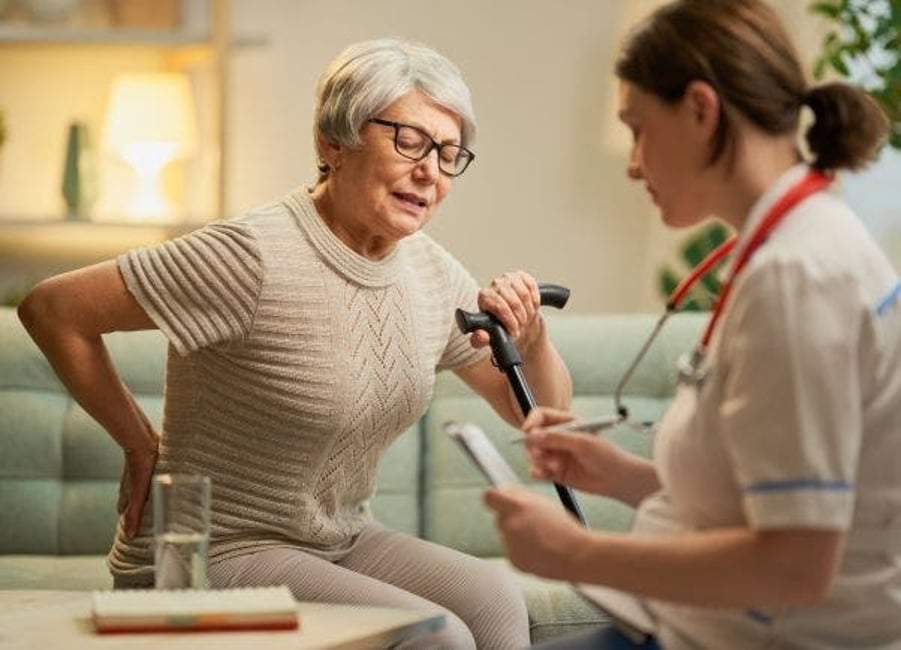Hip Fracture Rehabilitation: Literature Review

Description
Hip fractures are a major source of disability in older adults. This course, based on six recent peer-reviewed open-access articles, provides rehab professionals with current information on topics relevant to this patient population. The first article summarizes existing literature on the difference in outcomes between internal fixation, hemiarthroplasty, and total hip arthroplasty for femoral neck fractures in older adults. The second article reviews chemical VTE prevention regimens and provides recommendations for intervention after hip or knee arthroplasty. The third article examines complications after hip fracture surgery among patients on Coumadin. The fourth and fifth articles discuss home-based rehabilitation after hip fracture as compared to outpatient or skilled nursing facility care. The final article examines the relationship between measurable sarcopenia and health-related outcomes and mortality rates after hip fracture surgery. The information presented in this course can help improve and update the clinical practice of any rehab professional who treats older patients who have sustained a hip fracture.


Physicourses is an AOTA Approved Provider of professional development. Course approval ID# 6295. This distance learning-independent course is offered at 0.7 CEUs Intermediate Level, OT Service Delivery, Foundational Knowledge. AOTA does not endorse specific course content, products, or clinical procedures.
Available Course Credits
| Alaska State PT & OT Board | 7.00 | ||
 |
AOTA | 7.00 | |
| Arizona State Board of Physical Therapy | 7.00 | ||
| Arkansas State Board of Physcial Thearpy | 7.00 | ||
| California Physical Therapy Board | 7.00 | ||
| Colorado Division of Professions and Occupations | 7.00 | ||
| Connecticut Department of Public Health | 7.00 | ||
| Delaware Examining Board of Physical Therapists and Athletic Trainers | 7.00 | ||
| District Of Columbia Department of Health | 7.00 | ||
| FPTA | 7.00 | ||
| Georgia State Board of Physical Therapy | 7.00 | ||
| Hawaii Board of Physical Therapy | 7.00 | ||
| Idaho Physical Therapy Licensure Board | 7.00 | ||
| Indiana Physical Therapy Board | 7.00 | ||
| Iowa Board of Physical Therapy and Occupational Therapy | 7.00 | ||
| Kansas State Board of Healing Arts | 7.00 | ||
| Kentucky Board of Physical Therapy | 7.00 | ||
| Louisiana Physical Therapy Board | 7.00 | ||
| Maine Board of Physical Therapy | 7.00 | ||
| Maryland Board of Physical Therapy Examiners | 0.70 | ||
| Massachusetts Board of Allied Health Professionals | 7.00 | ||
| Michigan Board of Physical Therapy | 7.00 | ||
| Mississippi State Board of Physical Therapy | 7.00 | ||
| Missouri Advisory Commission for Physical Therapists | 7.00 | ||
| Montana Board of Physical Therapy Examiners | 7.00 | ||
| Nebraska Department of Health and Human Services | 7.00 | ||
| New Mexico Physical Therapy Board | 7.00 | ||
| North Carolina Board of Physical Therapy Examiners | 7.00 | ||
| North Dakota Board of Physical Therapy | 7.00 | ||
| Office of Professional Regulation, Vermont Secretary of State | 7.00 | ||
| Oklahoma Board of Medical Licensure and Supervision - Physical Therapy | 7.00 | ||
| Oregon Board of Physical Therapy | 7.00 | ||
| Pennsylvania Bureau of Professional and Occupational Affairs - Physical Therapy | 7.00 | ||
| Physical Therapy Governing Board New Hampshire | 7.00 | ||
| South Carolina Board of Physical Therapy | 7.00 | ||
| South Dakota Physical Therapy License Board | 7.00 | ||
| State of Alabama Board of Physical Therapy | 7.00 | ||
| State of Rhode Island Department of Health | 7.00 | ||
| Tennessee Board of Physical Therapy | 7.00 | ||
| Utah Physical Therapy Licensing Board | 7.00 | ||
| Virginia Board of Physical Therapy | 7.00 | ||
| Washington State Board of Physical Therapy | 7.00 | ||
| West Virginia Board of Physical Therapy | 7.00 | ||
| Wisconsin Physical Therapy License Board | 7.00 | ||
| Wyoming Board of Physical Therapy | 7.00 |
Course Content
| 1412 Hip Fracture Rehabilitation: Literature Review | Module | ||
| Course Evaluation | Module |
Sarah R.Stillings, MA, PT, MPT, CHT
Sarah R. (Sally) Stillings is a PT and Certified Hand Therapist in Texas. She received her physical therapy degree from the University of North Carolina at Chapel Hill. Prior to becoming a therapist, Sally taught university-level writing courses and was assistant editor of The Journal of Craniomandibular Practice. In her extensive career as a PT, she has held a variety of clinical, teaching, administrative, and business roles, including general PT practitioner, upper extremity specialist, clinic manager, hand therapy clinic coordinator, continuing education (CE) instructor, and CE course administrator. She has also served as Executive Director of the Kellermann Foundation, a U.S. nonprofit organization supporting healthcare and community development in Uganda, East Africa. Her work now focuses on creating evidence-based CE materials for rehab professionals. Sally is a lifelong runner who celebrates all those who cover the ground.

1412 Hip Fracture Rehabilitation: Literature Review—Course Objectives
After successfully completing this continuing education course, the learner should be able to: 1. Differentiate among the main surgical treatments of choice for femoral neck fractures based on their Garden classifications.
- Identify the pros and cons of cemented vs. noncemented prostheses for femoral neck fractures.
- Recognize the various mechanisms of preventing venous thromboembolism (VTE) after hip or knee arthroplasty based on the pharmaceutical agent that is used, and recall the authors’ recommendations regarding VTE chemical prophylaxis.
- Identify the study design, objectives, strengths, and limitations of the included studies. 5. Indicate the post-hip-fractures outcomes found in the studies, including: a. Complications in patients on Coumadin based on INR value groups
- Factors in whether patients are discharged home or to skilled nursing care c. Differences among inpatient, outpatient, and home-based rehab
- Association between probable sarcopenia and outcomes
- Recall the main conclusions of each article presented.
- Indicate ways in which the information presented in these articles may contribute to functional, occupation-focused practice.
- Identify how application of the information presented may:
- Guide assessment and intervention choices
- Help meet patient-specific rehabilitation goals
- Improve patient outcomes
1412 Hip Fracture Rehabilitation: Literature Review—Table of Contents
Hour 1
Course Instructions 3 About the Authors
Course Description
Course Objectives 6
Introduction 9 Article 1: 10 Surgical treatment of femoral neck fractures: a brief review (15 pages) Hour 2
Article 1 (continued)
Hour 3
Article 2: 11 Review of therapeutic options for the prevention of VTE in TJA (15 pages) Hour 4
Article 2 (continued)
Article 3: 12 Postop complications of hip fracture patients on chronic Coumadin (7 pages) Hour 5
Article 4: 13 Factors determining home vs. rehab discharge following primary TJA (6 pages)
Article 5: 14 Outpatient and home-based treatment…for hip fracture rehab (10 pages) Hour 6
Article 5 (continued)
Article 6: 15 Knee extension strength measures indicating probable sarcopenia (13 pages) Hour 7
Article 6 (continued)
Examination 17 Evaluation 23
Customer Cancellation:
Customers may request cancellations of their enrollment or subscription in our digital or live educational services, subject to the terms outlined below. Cancellation requests must be made in writing, either through email or through our designated cancellation process.
Refund Policy:
Refunds will be provided according to the following guidelines: i) For cancellation requests made within 5 days of the initial enrollment or subscription, a full refund will be issued. Refunds will be issued using the same method of payment used for the original transaction, unless otherwise agreed upon in writing.
Provider Cancellation:
In the event Physicourses cancels your course, you will be issued a full refund or transfered to a course of equal or greater value.
Physicourses Conflict of Interest Disclosure Policy for Authors and Staff:
All persons in a position to control the content of any educational activity (authors or staff from Physicourses) are required to disclose to Physicourses any potentially biasing or potential conflict of interests in relationships of a financial, professional, or personal nature.
The intent of this disclosure is not to prevent authors or staff with commercial affiliations from planning an educational activity, or to prevent a Presenter with commercial affiliations from presenting, but rather to inform Physicourses of any potentially biasing relationships so that conflicts are resolved prior to the activity.
It is the policy of Physicourses to ensure balance, independence, objectivity and scientific rigor in all of its continuing education activities. All relevant conflicts of interest identified by the planner, presenter, or as determined by Physicourses will be disclosed to the audience verbally and in writing prior to the start of the presentation.
Definitions for Authors/Staff:
Relevant financial relationships are those relationships in which you benefit by receiving a salary, royalty, intellectual property rights, gift, speaking fee, consulting fee, honoraria, ownership interest (e.g., stocks, stock options, or other ownership interest, excluding diversified mutual funds), or other financial benefit. Financial relationships can also include “contracted research” where the institution gets the grant and manages the funds and you are the principal or named investigator on the grant.
Educational Level: Intermediate
Target Audience: PT, PTA, OT, OTA
Course Completion Requirements: Passing an online exam with 70% or greater will be required to earn continuing education credit
This course is approved for 0.7 CEUS. 7 contact hours
Physicourses is committed to ensuring accessibility to the most extensive audience possible. If you have any questions or special needs requests, please contact us at info@physicourses.com.